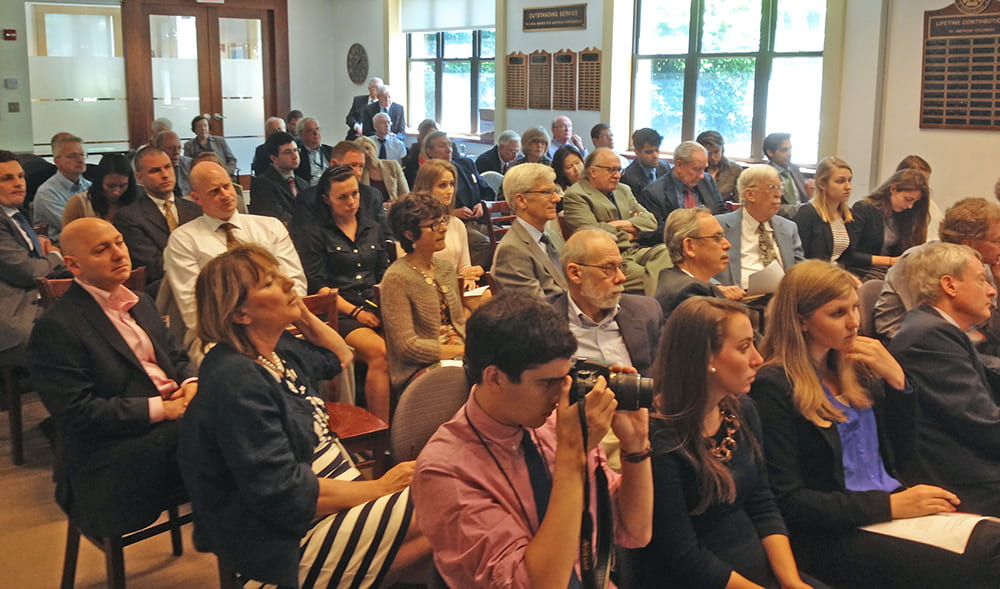WASHINGTON — Moscow’s propaganda machine has vastly outmatched the U.S., according to speakers here today at the June CCLP Washington Communication Leadership forum.
“Russia has spent the past twenty years building up,” said William Stevens, Director of the Ukraine Communications Task Force at the U.S. State Department, while Washington spent two decades dialing back.

Left to right: WIlliam Stevens, Director of the Ukraine Communications Task Force at the U.S. State Department; Myroslava Gongadze, TV anchor and reporter at Voice of America’s Ukrainian Service; and Nenad Pejic, Interim Manager of Radio Free Europe/Radio Liberty.
The Kremlin’s aggressive media campaign is effective across all platforms, including newspapers, social media and television, according to Myroslava Gongadze, TV anchor and reporter at Voice of America’s Ukrainian Service.
Nenad Pejic, Interim Manager of Radio Free Europe/Radio Liberty went even further, saying the Russian campaign goes beyond propaganda, to include “a media campaign, a political campaign, a cultural campaign, an energy campaign, a military campaign… Media propaganda is [just] part of it.”
One example of recent fabrications, said Pejic, was the reporting of fake election polls in the Ukraine, polls which Pejic said were entirely invented by Kremlin propagandists.
Another example cited by Pejic involved Russian claims that could easily be challenged.
“At the very beginning of the protest in Kiev, while Yanukovich was still in power, Russian and Ukrainian TV stations reported that few hundred protesters occupied Independence square in Kiev,” Pejic said. “This is what RFERL did: we sent [a] cameraman to the top of TV tower, we put small camera on his helmet and this is the result.” He then played a video from RFERL which showed not hundreds but hundreds of thousands of protesters.
“Russian citizens today live in a fairy tale,” Pejic added. “Every day, every hour, every second, there are new lies.”
In fact, Gongadze said, Moscow’s propaganda has been especially effective inside of Russia.
“The Kremlin’s biggest propaganda success so far has been winning over the minds and hearts of the Russian population,” she said. “Prior to the crisis, there was high dissatisfaction with Putin. After the annexation of Crimea, there is majority support for Putin among Russians.”
Gongadze said most Americans have no idea of the extent or intensity of the Kremlin campaign, because little of it appears in U.S. media. She pointed to the Stop Fake website as a good source for Westerners to use to monitor daily fabrications by Russian media.
Stevens said it is difficult for Americans to imagine how intense the Kremlin’s fabrications are because U.S. media do not report on them every day – while Russian television, newspapers and web sites repeat them daily and even hourly. And according to Stevens, the Kremlin has mastered social media.
“Russia Today has hacked Google,” he said, noting that search results for news stories and videos are dominated by fake Kremlin videos and fabricated news stories.

One member of today’s audience offered an explanation: David Henderson, a former CBS News correspondent who now runs News Strategies, told participants that his analysis of Russian propaganda on social networks indicates Moscow is using newer, more powerful software — software made in the U.S. and available for free — to increase the Kremlin’s profile on Google and other search engines. The U.S. still uses software that is at least a decade old.
Another reason for Russian dominance is simple, according to today’s panelists: No one in Washington is making a priority of responding to Moscow’s propaganda.
Today’s CCLP Washington Communication Leadership forum was part of a monthly series of First Monday lunch forums presented in partnership with the USC Center on Public Diplomacy and the Public Diplomacy Council.